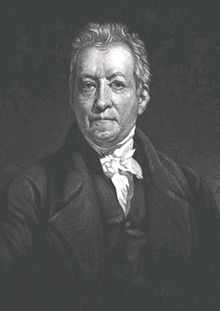James Haldane
| James Haldane | |
|---|---|
 | |
| Born |
James Alexander Haldane 14 July 1768 Dundee, Scotland |
| Died |
8 February 1851 (aged 82) Edinburgh, Scotland |
| Nationality | Scottish |
| Occupation | Evangelist |
| Spouse(s) |
Mary Joass Margaret Rutherford |
| Children |
Elizabeth Haldane Catharine Haldane James Haldane Alexander Haldane Mary Haldane Margaret Haldane Robert Haldane Isabella Mitchelson Haldane Daniel Rutherford Haldane Adamina Dundas Duncan Haldane Helen Haldane George Oswald Haldane James Haldane |
| Theological work | |
| Tradition or movement |
Church of Scotland Independent Baptist |
James Alexander Haldane (14 July 1768 – 8 February 1851) was a Scottish independent church leader.
Biography
The younger son of Captain James Haldane of Airthrey House, (his older brother Robert Haldane was also a clergyman) in Stirlingshire, he was born at Dundee. Educated first at Dundee Grammar School and afterwards at the Royal High School and University of Edinburgh, at the age of seventeen he joined the Duke of Montrose East Indiaman as a midshipman. After four voyages to India he was nominated to the command of the Melville Castle in the summer of 1793; but having begun a careful study of the Bible during his voyages, and also come under the evangelical influence of David Bogue of Gosport, one of the founders of the London Missionary Society, he abruptly decided to leave the navy for a religious life, and returned to Scotland.
Family
He married twice and had 13 children. He married first Mary Joass on 18 September 1793.[1] Believed to have been born on 27 October 1771,[2] she died on 27 February 1819.[1] They had the following children:
- Elizabeth Haldane (1794–1843)
- Catharine Haldane (1797–1885)
- James Haldane b: (1799–1831)
- Alexander Haldane (15 October 1800[3]-19 July 1882[4])
- Among whose children was Alexander Chinnery-Haldane (1842–1906), Bishop of Argyll and the Isles
- Mary Haldane (?-7 November 1857[5])
- Margaret Haldane (1803–1889)
- Robert Haldane (1805–1877)
In 1822 he married for a second time to Margaret Rutherford, daughter of Daniel Rutherford. They had the following children:
- Isabella Mitchelson Haldane (1823–1892), married Richard Burdon-Sanderson (1821–1876) in 1853
- Daniel Rutherford Haldane (1824–1887), physician.
- Adamina Dundas Duncan Haldane (1826–1898)
- Helen Haldane (1828–1873)
- George Oswald Haldane (1829–1831)
- James Haldane
Evangelism
In about 1796 he became acquainted with the celebrated evangelical, Charles Simeon of Cambridge, in whose company he toured Scotland, distributing tracts and trying to awaken others to an interest in religious subjects. In May 1797 he preached his first sermon, at Gilmerton near Edinburgh, with encouraging success. In the same year he established a non-sectarian organization for tract distribution and lay preaching called the "Society for the Propagation of the Gospel at Home". During the next few years he made repeated missionary journeys, preaching wherever he could obtain hearers, and generally in the open air.
Originally loyal to the Church of Scotland, his studies of the New Testament led him to leave that denomination behind and work in an independent church movement. Along with his brother, Robert Haldane, and others, James established 85 Churches of Christ in Scotland and Ireland. This was the result of a return to the New Testament for doctrine and practice in lieu of denominational traditions. Churches planted by the Haldanes practiced baptism by immersion, weekly communion, and congregational polity (aunonomous government). The Haldanes also operated a seminary and were influenced in their principles by other non-denominational thinkers such as John Glas and Robert Sandeman.
As advancing years compelled him to withdraw from the more exhausting labours of travel and open-air preaching, he sought to influence the discussion of current religious and theological questions by means of the press. He died on 8 February 1851 aged 82 and is commemorated on a Haldane family gravestone in the churchyard at St Cuthbert's, Edinburgh.
Bibliography
Among J. A. Haldane's numerous contributions to current theological discussions were:
- The Duty of Christian Forbearance in Regard to Points of Church Order (1811)
- Strictures on a Publication upon Primitive Christianity by Mr John Walker (1819)
- Refutation of Edward Irving's Heretical Doctrines respecting the Person and Atonement of Jesus Christ. His Observations on Universal Pardon, etc., was a contribution to the controversy regarding the views of Thomas Erskine of Linlathen and Campbell of Row.
- Man's Responsibility (1842) is a reply to Howard Hinton on the nature and extent of the Atonement.
He also published:
- Journal of a Tour in the North (1801)
- Early Instruction Commended (1801)
- Views of the Social Worship of the First Churches (1805)
- The Doctrine and Duty of Self-Examination (1806)
- The Doctrine of tile Atonement (1845)
- Exposition of the Epistle to the Galatians (1848).
See also
Notes
- ↑ 1.0 1.1 "thePeerage.com - Person Page 31098". Retrieved 2010-08-19.
- ↑ http://www.stanford.edu/group/auden/cgi-bin/auden/individual.php?pid=I1573&ged=auden-bicknell.ged&view=preview retrieved on 19 August 2010.
- ↑ http://thepeerage.com/p31098.htm#i310973 retrieved 19 August 2010.
- ↑ John Wolffe, ‘Haldane, Alexander (1800–1882)’, rev. Oxford Dictionary of National Biography, Oxford University Press, 2004, accessed 1 Sept 2010
- ↑ http://thepeerage.com/p31108.htm#i311071 retrieved 19 August 2010.
References
-
 This article incorporates text from a publication now in the public domain: Chisholm, Hugh, ed. (1911). "Haldane, James Alexander". Encyclopædia Britannica (11th ed.). Cambridge University Press
This article incorporates text from a publication now in the public domain: Chisholm, Hugh, ed. (1911). "Haldane, James Alexander". Encyclopædia Britannica (11th ed.). Cambridge University Press
External links
 Wood, James, ed. (1907). "Haldane, James". The Nuttall Encyclopædia. London and New York: Frederick Warne.
Wood, James, ed. (1907). "Haldane, James". The Nuttall Encyclopædia. London and New York: Frederick Warne. "Haldane. II. James Alexander". The American Cyclopædia. 1879.
"Haldane. II. James Alexander". The American Cyclopædia. 1879.